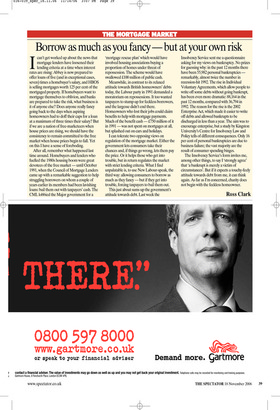Borrow as much as you fancy — but at your own risk
Ican’t get worked up about the news that mortgage lenders have loosened their lending criteria at a time when interest rates are rising: Abbey is now prepared to offer loans of five (and in exceptional cases, seven) times a homebuyer’s salary, and HBOS is selling mortgages worth 125 per cent of the mortgaged property. If homebuyers want to mortgage themselves to oblivion, and banks are prepared to take the risk, what business is it of anyone else? Does anyone really fancy going back to the days when aspiring homeowners had to doff their caps for a loan at a maximum of three times their salary? But if we are a nation of free-marketeers when house prices are rising, we should have the consistency to remain committed to the free market when house prices begin to fall. Yet on this I have a sense of foreboding.
After all, remember what happened last time around. Homebuyers and lenders who fuelled the 1980s housing boom were great devotees of the free market — until October 1991, when the Council of Mortgage Lenders came up with a remarkable suggestion to help struggling borrowers on whom a couple of years earlier its members had been lavishing loans: bail them out with taxpayers’ cash. The CML lobbied the Major government for a ‘mortgage rescue plan’ which would have involved housing associations buying a proportion of homes under threat of repossession. The scheme would have swallowed £100 million of public cash.
Meanwhile, in contrast to its relaxed attitude towards British homeowners’ debts today, the Labour party in 1991 demanded a moratorium on repossessions. It too wanted taxpayers to stump up for feckless borrowers, and the largesse didn’t end there. Homeowners who lost their jobs could claim benefits to help with mortgage payments. Much of the benefit cash — £750 million of it in 1991 — was not spent on mortgages at all, but splashed out on cars and holidays.
I can tolerate two opposing views on regulation of the mortgage market. Either the government lets consumers take their chances and, if things go wrong, lets them pay the price. Or it helps those who get into trouble, but in return regulates the market with strict lending criteria. What I find unpalatable is, to use New Labour-speak, the third way: allowing consumers to borrow as much as they fancy — but if they get into trouble, forcing taxpayers to bail them out.
This just about sums up the government’s attitude towards debt. Last week the Insolvency Service sent me a questionnaire asking for my views on bankruptcy. No prizes for guessing why: in the past 12 months there have been 55,982 personal bankruptcies remarkably, almost twice the number in recession-hit 1992. The rise in Individual Voluntary Agreements, which allow people to write off some debts without going bankrupt, has been even more dramatic: 88,164 in the past 12 months, compared with 36,794 in 1992. The reason for the rise is the 2002 Enterprise Act, which made it easier to write off debts and allowed bankrupts to be discharged in less than a year. The aim was to encourage enterprise, but a study by Kingston University’s Centre for Insolvency Law and Policy tells of different consequences. Only 16 per cent of personal bankruptcies are due to business failure; the vast majority are the result of consumer spending binges.
The Insolvency Service’s form invites me, among other things, to say I ‘strongly agree’ that ‘a bankrupt is merely a victim of circumstances’. But if it expects a touchy-feely attitude towards debt from me, it can think again. As far as I’m concerned, charity does not begin with the feckless homeowner.
Ross Clark


































































































 Previous page
Previous page